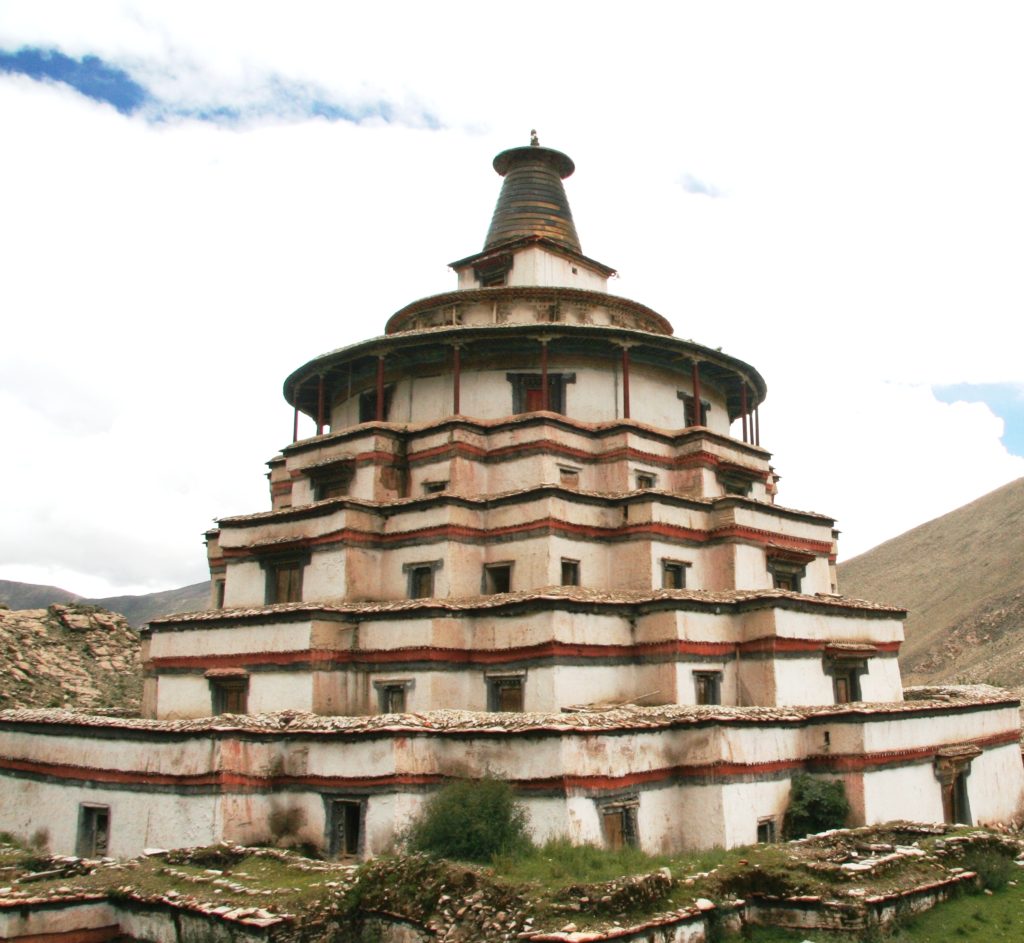Puntsok Pelzang

Puntsok Pelzang, who was one of the Dharma lord Dölpopa’s fourteen major disciples, first studied extensively in the Kagyu tradition. After seeing a copy of Dolpopa’s Ocean of Definitive Meaning, he went to meet the great master and received many special teachings. He later lived and taught in Central Tibet, first at Sangpu Monastery and then in Penyul north of Lhasa. He mostly practiced and taught the Kalacakra tradition and the six-branch yoga.
Puntsok Pelzang was born in the Penyul (‘phan yul) region of Central Tibet. At seventeen years of age he traveled to the Kagyu monastery of Taklung (stag lung), where he received ordination as a novice monk, studied the treatises of the vehicle of the perfections, epistemology, abhidharma, and the monastic code, received all the initiations and guiding instructions, and became an expert in calligraphy and painting. He also studied the Five Treatises of Maitreya and epistemology at Dewachen (bde ba can) Monastery.
Puntsok Pelzang then traveled to the great Karma Kagyu monastery of Tsurpu (mtshur phu), where he received the Tantra Trilogy of Hevajra, the cycle of Yamari, and many other transmissions from the third Karmapa, Rangjung Dorje (karma pa rang byung rdo rje, 1284-1339). While at Tsurpu, he also received from Tokden Drakseng (rtogs ldan grags seng, d. 1349) the Six Dharmas of Niguma, the Six Dharmas of Naropa, the cycle of Vajravarahi, the initations of Cakrasamvara in several traditions, and the initiation of Guhyasamaja. During this visit Puntsok Palsang saw a copy of the Dharma lord Dolpopa’s Ocean of Definitive Meaning (nges don rgya mtsho) and his faith in Dölpopa’s teaching caused the hairs of his body to stand on end. He was moved to tears and made strong prayers to be able to receive such a teaching, realize it, and teach it to others.
Puntsok Pelzang then traveled to the famous Kadam monastery of Nartang, where the Dharma lord Dölpopa was teaching an assembly of about 1,000 monks. He received the Kālacakra initiation from Dölpopa, and, when hearing the instructions of the six-branch yoga, an exceptional experience arose in which he remembered many previous lifetimes in India, Nepal, and Tibet during which he had received and practiced these same instructions. He also sang a spiritual song describing these events. Then he received from Dölpopa many further teachings, such as the great Vimalaprabha commentary on the Kalacakra Tantra, the Guhyasamaja Tantra, Nagarjuna’s Madhyamaka treatises known as the Eulogy Collection (bstod tshogs), and the ten sutras of definitive meaning.
Puntsok Pelzang received full monastic ordination from Dölpopa and was then invited to teach in the monastery of Sangpu (gsang phu) in Central Tibet. Along the way he received further teachings from other masters, such as the great Buton Rinchen Drup (bu ston rin chen grub, 1290–1364) at Zhalu (zhwa lu) Monastery, and Dolpopa’s major disciple Chogle Namgyal (phyogs las rnam rgyal, 1306–1386).
After arriving at Sangpu, Puntsok Pelzang gave initiations and taught the six-branch yoga at several monasteries. In 1363 he went to Babrim (‘bab rim) Monastery and gave many teachings such as the Kālacakra initiation, the Vimalaprabha, the six-branch yoga, and the ten sutras of definitive meaning. In 1365 he traveled to Lhasa and taught the Mind Training (blo sbyong) instructions to a large assembly. During this visit he engaged in an extensive debate with many hundreds and thousands of monks from the great Geluk monasteries of Sera (se ra) and Drepung (‘bras spung) who were described as adherents to a nihilistic view (chad lta), and they all gained great respect for him.
Then Puntsok Pelzang founded the hermitage of Kalapa (ka la pa) in the Penyul (‘phan yul) region where he had been born north of Lhasa. There he gave the tantric teachings of the six-branch yoga and the Vimalaprabhā to students of the highest ability, and teachings such as the Bodhisattvacaryāvatāra to others. When Puntsok Pelzang passed away, marvelous signs are said to have occurred just as described in the tantric scriptures, and he rested in clear light for seven days. Further wonderful signs appeared during his cremation and amazing relics emerged from his bones.
This summary of Puntsok Pelzang’s life is based on the work of the Jonang abbot Gyalwa Josang Palsangpo (rgyal ba jo bzang dpal bzang po): Brilliant Marvels: Abbreviated Biographies of the Great Omniscient Dharma Lord, the Spiritual Father, and His Fourteen Spiritual Sons. Chos kyi rje kun mkhyen chen po yab sras bco lnga’i rnam thar nye bar bsdus pa ngo mtshar rab gsal, 619–23. This text is included in the ‘Dzam thang dbu can edition of Dölpopa’s Gsung ‘bum, vol. 1: 559–629. The same work has also been published in Jangsem Gyalwa Yeshe (byang sems rgyal ba ye shes), Biographies of the Masters in the Lineage of the Jonangpa Tradition of Glorious Kālacakra. Dpal ldan dus kyi ‘khor lo jo nang pa’i lugs kyi bla ma brgyud pa’i rnam thar, 143–209. Beijing: Mi rigs dpe skrun khang, 2004. The following work was also used: Ngawang Losang Drakpa (ngag dbang blo gros grags pa). Moonlamp Illuminating the Glorious Jonangpa Dharma Tradition. Dpal ldan jo nang pa’i chos ‘byung rgyal ba’i chos tshul gsal byed zla ba’i sgron me, 36. Koko Nor: Krung go’i bod kyi shes rig dpe skrun khang, 1992.
